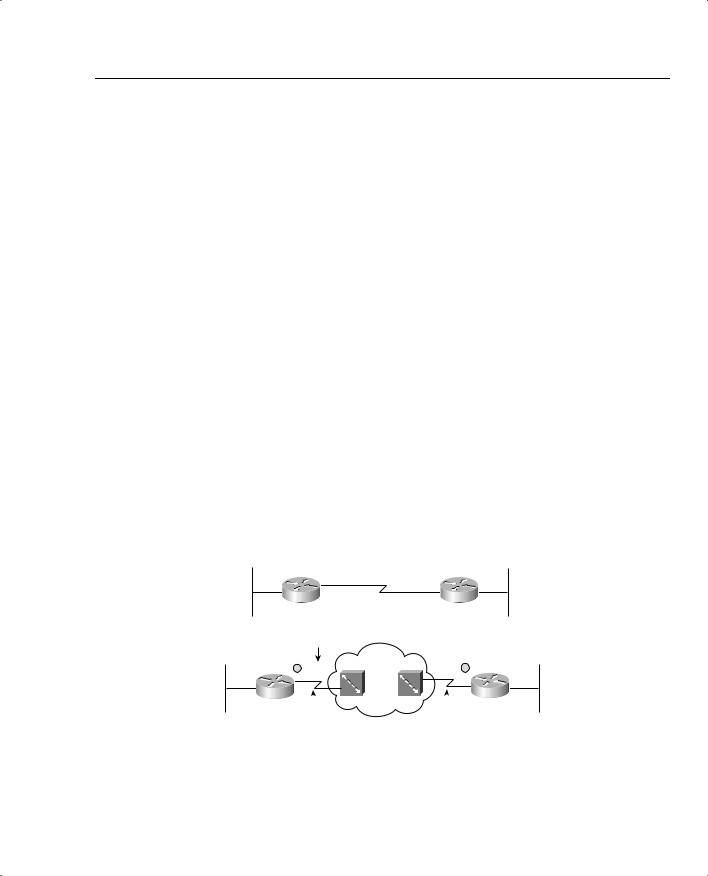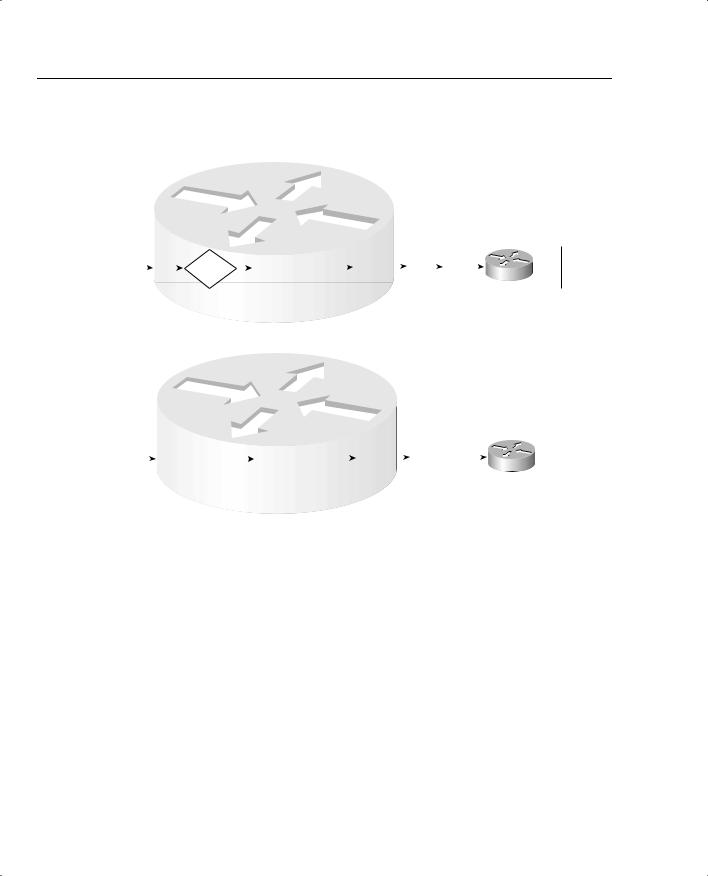
- •QoS Overview
- •“Do I Know This Already?” Quiz
- •QoS: Tuning Bandwidth, Delay, Jitter, and Loss Questions
- •Foundation Topics
- •QoS: Tuning Bandwidth, Delay, Jitter, and Loss
- •Bandwidth
- •The clock rate Command Versus the bandwidth Command
- •QoS Tools That Affect Bandwidth
- •Delay
- •Serialization Delay
- •Propagation Delay
- •Queuing Delay
- •Forwarding Delay
- •Shaping Delay
- •Network Delay
- •Delay Summary
- •QoS Tools That Affect Delay
- •Jitter
- •QoS Tools That Affect Jitter
- •Loss
- •QoS Tools That Affect Loss
- •Summary: QoS Characteristics: Bandwidth, Delay, Jitter, and Loss
- •Voice Basics
- •Voice Bandwidth Considerations
- •Voice Delay Considerations
- •Voice Jitter Considerations
- •Voice Loss Considerations
- •Video Basics
- •Video Bandwidth Considerations
- •Video Delay Considerations
- •Video Jitter Considerations
- •Video Loss Considerations
- •Comparing Voice and Video: Summary
- •IP Data Basics
- •Data Bandwidth Considerations
- •Data Delay Considerations
- •Data Jitter Considerations
- •Data Loss Considerations
- •Comparing Voice, Video, and Data: Summary
- •Foundation Summary
- •QoS Tools and Architectures
- •“Do I Know This Already?” Quiz
- •QoS Tools Questions
- •Differentiated Services Questions
- •Integrated Services Questions
- •Foundation Topics
- •Introduction to IOS QoS Tools
- •Queuing
- •Queuing Tools
- •Shaping and Policing
- •Shaping and Policing Tools
- •Congestion Avoidance
- •Congestion-Avoidance Tools
- •Call Admission Control and RSVP
- •CAC Tools
- •Management Tools
- •Summary
- •The Good-Old Common Sense QoS Model
- •GOCS Flow-Based QoS
- •GOCS Class-Based QoS
- •The Differentiated Services QoS Model
- •DiffServ Per-Hop Behaviors
- •The Class Selector PHB and DSCP Values
- •The Assured Forwarding PHB and DSCP Values
- •The Expedited Forwarding PHB and DSCP Values
- •The Integrated Services QoS Model
- •Foundation Summary
- •“Do I Know This Already?” Quiz Questions
- •CAR, PBR, and CB Marking Questions
- •Foundation Topics
- •Marking
- •IP Header QoS Fields: Precedence and DSCP
- •LAN Class of Service (CoS)
- •Other Marking Fields
- •Summary of Marking Fields
- •Class-Based Marking (CB Marking)
- •Network-Based Application Recognition (NBAR)
- •CB Marking show Commands
- •CB Marking Summary
- •Committed Access Rate (CAR)
- •CAR Marking Summary
- •Policy-Based Routing (PBR)
- •PBR Marking Summary
- •VoIP Dial Peer
- •VoIP Dial-Peer Summary
- •Foundation Summary
- •Congestion Management
- •“Do I Know This Already?” Quiz
- •Queuing Concepts Questions
- •WFQ and IP RTP Priority Questions
- •CBWFQ and LLQ Questions
- •Comparing Queuing Options Questions
- •Foundation Topics
- •Queuing Concepts
- •Output Queues, TX Rings, and TX Queues
- •Queuing on Interfaces Versus Subinterfaces and Virtual Circuits (VCs)
- •Summary of Queuing Concepts
- •Queuing Tools
- •FIFO Queuing
- •Priority Queuing
- •Custom Queuing
- •Weighted Fair Queuing (WFQ)
- •WFQ Scheduler: The Net Effect
- •WFQ Scheduling: The Process
- •WFQ Drop Policy, Number of Queues, and Queue Lengths
- •WFQ Summary
- •Class-Based WFQ (CBWFQ)
- •CBWFQ Summary
- •Low Latency Queuing (LLQ)
- •LLQ with More Than One Priority Queue
- •IP RTP Priority
- •Summary of Queuing Tool Features
- •Foundation Summary
- •Conceptual Questions
- •Priority Queuing and Custom Queuing
- •CBWFQ, LLQ, IP RTP Priority
- •Comparing Queuing Tool Options
- •“Do I Know This Already?” Quiz
- •Shaping and Policing Concepts Questions
- •Policing with CAR and CB Policer Questions
- •Shaping with FRTS, GTS, DTS, and CB Shaping
- •Foundation Topics
- •When and Where to Use Shaping and Policing
- •How Shaping Works
- •Where to Shape: Interfaces, Subinterfaces, and VCs
- •How Policing Works
- •CAR Internals
- •CB Policing Internals
- •Policing, but Not Discarding
- •Foundation Summary
- •Shaping and Policing Concepts
- •“Do I Know This Already?” Quiz
- •Congestion-Avoidance Concepts and RED Questions
- •WRED Questions
- •FRED Questions
- •Foundation Topics
- •TCP and UDP Reactions to Packet Loss
- •Tail Drop, Global Synchronization, and TCP Starvation
- •Random Early Detection (RED)
- •Weighted RED (WRED)
- •How WRED Weights Packets
- •WRED and Queuing
- •WRED Summary
- •Flow-Based WRED (FRED)
- •Foundation Summary
- •Congestion-Avoidance Concepts and Random Early Detection (RED)
- •Weighted RED (WRED)
- •Flow-Based WRED (FRED)
- •“Do I Know This Already?” Quiz
- •Compression Questions
- •Link Fragmentation and Interleave Questions
- •Foundation Topics
- •Payload and Header Compression
- •Payload Compression
- •Header Compression
- •Link Fragmentation and Interleaving
- •Multilink PPP LFI
- •Maximum Serialization Delay and Optimum Fragment Sizes
- •Frame Relay LFI Using FRF.12
- •Choosing Fragment Sizes for Frame Relay
- •Fragmentation with More Than One VC on a Single Access Link
- •FRF.11-C and FRF.12 Comparison
- •Foundation Summary
- •Compression Tools
- •LFI Tools
- •“Do I Know This Already?” Quiz
- •Foundation Topics
- •Call Admission Control Overview
- •Call Rerouting Alternatives
- •Bandwidth Engineering
- •CAC Mechanisms
- •CAC Mechanism Evaluation Criteria
- •Local Voice CAC
- •Physical DS0 Limitation
- •Max-Connections
- •Voice over Frame Relay—Voice Bandwidth
- •Trunk Conditioning
- •Local Voice Busyout
- •Measurement-Based Voice CAC
- •Service Assurance Agents
- •SAA Probes Versus Pings
- •SAA Service
- •Calculated Planning Impairment Factor
- •Advanced Voice Busyout
- •PSTN Fallback
- •SAA Probes Used for PSTN Fallback
- •IP Destination Caching
- •SAA Probe Format
- •PSTN Fallback Scalability
- •PSTN Fallback Summary
- •Resource-Based CAC
- •Resource Availability Indication
- •Gateway Calculation of Resources
- •RAI in Service Provider Networks
- •RAI in Enterprise Networks
- •RAI Operation
- •RAI Platform Support
- •Cisco CallManager Resource-Based CAC
- •Location-Based CAC Operation
- •Locations and Regions
- •Calculation of Resources
- •Automatic Alternate Routing
- •Location-Based CAC Summary
- •Gatekeeper Zone Bandwidth
- •Gatekeeper Zone Bandwidth Operation
- •Single-Zone Topology
- •Multizone Topology
- •Zone-per-Gateway Design
- •Gatekeeper in CallManager Networks
- •Zone Bandwidth Calculation
- •Gatekeeper Zone Bandwidth Summary
- •Integrated Services / Resource Reservation Protocol
- •RSVP Levels of Service
- •RSVP Operation
- •RSVP/H.323 Synchronization
- •Bandwidth per Codec
- •Subnet Bandwidth Management
- •Monitoring and Troubleshooting RSVP
- •RSVP CAC Summary
- •Foundation Summary
- •Call Admission Control Concepts
- •Local-Based CAC
- •Measurement-Based CAC
- •Resources-Based CAC
- •“Do I Know This Already?” Quiz
- •QoS Management Tools Questions
- •QoS Design Questions
- •Foundation Topics
- •QoS Management Tools
- •QoS Device Manager
- •QoS Policy Manager
- •Service Assurance Agent
- •Internetwork Performance Monitor
- •Service Management Solution
- •QoS Management Tool Summary
- •QoS Design for the Cisco QoS Exams
- •Four-Step QoS Design Process
- •Step 1: Determine Customer Priorities/QoS Policy
- •Step 2: Characterize the Network
- •Step 3: Implement the Policy
- •Step 4: Monitor the Network
- •QoS Design Guidelines for Voice and Video
- •Voice and Video: Bandwidth, Delay, Jitter, and Loss Requirements
- •Voice and Video QoS Design Recommendations
- •Foundation Summary
- •QoS Management
- •QoS Design
- •“Do I Know This Already?” Quiz
- •Foundation Topics
- •The Need for QoS on the LAN
- •Layer 2 Queues
- •Drop Thresholds
- •Trust Boundries
- •Cisco Catalyst Switch QoS Features
- •Catalyst 6500 QoS Features
- •Supervisor and Switching Engine
- •Policy Feature Card
- •Ethernet Interfaces
- •QoS Flow on the Catalyst 6500
- •Ingress Queue Scheduling
- •Layer 2 Switching Engine QoS Frame Flow
- •Layer 3 Switching Engine QoS Packet Flow
- •Egress Queue Scheduling
- •Catalyst 6500 QoS Summary
- •Cisco Catalyst 4500/4000 QoS Features
- •Supervisor Engine I and II
- •Supervisor Engine III and IV
- •Cisco Catalyst 3550 QoS Features
- •Cisco Catalyst 3524 QoS Features
- •CoS-to-Egress Queue Mapping for the Catalyst OS Switch
- •Layer-2-to-Layer 3 Mapping
- •Connecting a Catalyst OS Switch to WAN Segments
- •Displaying QoS Settings for the Catalyst OS Switch
- •Enabling QoS for the Catalyst IOS Switch
- •Enabling Priority Queuing for the Catalyst IOS Switch
- •CoS-to-Egress Queue Mapping for the Catalyst IOS Switch
- •Layer 2-to-Layer 3 Mapping
- •Connecting a Catalyst IOS Switch to Distribution Switches or WAN Segments
- •Displaying QoS Settings for the Catalyst IOS Switch
- •Foundation Summary
- •LAN QoS Concepts
- •Catalyst 6500 Series of Switches
- •Catalyst 4500/4000 Series of Switches
- •Catalyst 3550/3524 Series of Switches
- •QoS: Tuning Bandwidth, Delay, Jitter, and Loss
- •QoS Tools
- •Differentiated Services
- •Integrated Services
- •CAR, PBR, and CB Marking
- •Queuing Concepts
- •WFQ and IP RTP Priority
- •CBWFQ and LLQ
- •Comparing Queuing Options
- •Conceptual Questions
- •Priority Queuing and Custom Queuing
- •CBWFQ, LLQ, IP RTP Priority
- •Comparing Queuing Tool Options
- •Shaping and Policing Concepts
- •Policing with CAR and CB Policer
- •Shaping with FRTS, GTS, DTS, and CB Shaping
- •Shaping and Policing Concepts
- •Congestion-Avoidance Concepts and RED
- •WRED
- •FRED
- •Congestion-Avoidance Concepts and Random Early Detection (RED)
- •Weighted RED (WRED)
- •Flow-Based WRED (FRED)
- •Compression
- •Link Fragmentation and Interleave
- •Compression Tools
- •LFI Tools
- •Call Admission Control Concepts
- •Local-Based CAC
- •Measurement-Based CAC
- •Resources-Based CAC
- •QoS Management Tools
- •QoS Design
- •QoS Management
- •QoS Design
- •LAN QoS Concepts
- •Catalyst 6500 Series of Switches
- •Catalyst 4500/4000 Series of Switches
- •Catalyst 3550/3524 Series of Switches
- •Foundation Topics
- •QPPB Route Marking: Step 1
- •QPPB Per-Packet Marking: Step 2
- •QPPB: The Hidden Details
- •QPPB Summary
- •Flow-Based dWFQ
- •ToS-Based dWFQ
- •Distributed QoS Group–Based WFQ
- •Summary: dWFQ Options

QoS: Tuning Bandwidth, Delay, Jitter, and Loss 9
Unfortunately, improving one QoS characteristic might degrade another. Bandwidth defines the capacity of the transmission media. Compression tools reduce the amount of bandwidth needed to send all packets, but the compression process adds some delay per packet and also consumes CPU cycles. Jitter is the variation in delay between consecutive packets, so it is sometimes called “delay variation.” A router can reduce jitter for some traffic, but that usually increases delay and jitter for other traffic flows. QoS features can address jitter problems, particularly the queuing features that have priority queuing for packets that need low jitter. Packet loss can occur because of transmission errors, and QoS mechanisms cannot do much about that. However, more packets might be lost due to queues filling up rather than transmission errors— and QoS features can affect which packets are dropped.
You can think of QoS as “managed fairness” and, conversely, as “managed unfairness.” The real key to QoS success requires you to improve a QoS characteristic for a flow that needs that characteristic, while degrading that same characteristic for a flow that does not need that characteristic. For instance, QoS designs should decrease delay for delay-sensitive traffic, while increasing delay for delay-insensitive traffic.
The next four short sections take a closer look at each of these four traffic characteristics.
Bandwidth
The term “bandwidth” refers to the number of bits per second that can reasonably be expected to be successfully delivered across some medium. In some cases, bandwidth equals the physical link speed, or the clock rate, of the interface. In other cases, bandwidth is smaller than the actual speed of the link. Consider, for example, Figure 1-2, which shows two typical networks, one with a point-to-point serial link, and the other using Frame Relay.
Figure 1-2 Two Similar Networks, One with Point-to-Point, One with Frame Relay
R1 |
R2 |
CIR - 128 kbps
|
|
|
|
|
R4 |
R3 |
|
|
|
||
|
|
|
|||
|
|
|
|
||
Access Rate: 256 kbps |
Access Rate: 1.544 Mbps |
||||
In the point-to-point network, WAN bandwidth equals the physical link speed, or clock rate, on the physical medium. Suppose, for instance, that the link is a 64-kbps link—you could reasonably expect to send 64 kbps worth of traffic, and expect it to get to the other side of the

10 Chapter 1: QoS Overview
link. You would never expect to send more than that, because you cannot send the bits any faster than the clock rate of the interface. Bandwidth, in this case, is indeed rather obvious; you get 64 kbps in both directions.
The Frame Relay network provides a contracted amount of bandwidth. In practice, however, many installations expect more than that! The committed information rate (CIR) defines how much bandwidth the provider guarantees will pass through their network between the data terminal equipment (DTE) at each end of a virtual circuit (VC). That guarantee is a business proposition—a Layer 8 issue using the OSI reference model. On some occasions, you might not actually even get CIR worth of bandwidth. However, the Frame Relay provider commits to engineering a network so that they can support at least the CIRs of their collective VCs. In effect, bandwidth per VC equals the CIR of each VC, respectively.
Unfortunately, bandwidth on multiaccess networks is not that simple. Consider the fact that R3 has a 256-kbps access rate, and R4 has a T1 access rate. When R3 sends, it must send the bits at access rate—otherwise, Layer 1 functions would not work at all. Similarly, R4 must send at T1 speed. One of Frame Relay’s big selling points throughout its large growth years was that you “get something for nothing”—you pay for CIR of x, and you get more than x worth of bandwidth. In fact, many data network engineers design networks assuming that you will get an average of one and a half to two times CIR over each VC. If R3 and R4 send too much, and the provider’s switches have full queues, the frames are discarded, and the data has to be re-sent. If you pay for 128-kbps CIR between R3 and R4, and over time actually send at 192 kbps, or 256 kbps, and it works, how much bandwidth do you really have? Well, on a multiaccess network, such as Frame Relay or ATM, the actual amount of bandwidth is certainly open to argument.
Frame Relay bandwidth might even be less than CIR in practice. Suppose that R4 is the main site, and there are 15 remote sites identical to R3 (including R3). Can you reasonably expect to send at 128 kbps (CIR) to all 15 sites, at the same time, when R4 has a 1.544-Mbps access rate? No! All 15 sites sending at 128 kbps requires 1.920 Mbps, and R4 can only send and receive at 1.544 Mbps. Would an engineer design a network like this? Yes! The idea being that if data is being sent to all VCs simultaneously, either R4 will queue the data (for packets going right to left), or the Frame Relay switch will queue the data (for packets going left to right). If data is not being sent to all 15 remote sites at the same time, you get (at least) 128 kbps to each site that needs the bandwidth at that time. The negative effect is that a larger percentage of packets are dropped due to full queues; however, for data networks that is typically a reasonable tradeoff. For traffic that is not tolerant to loss, such as voice and video, this type of design may not be reasonable.
Throughout this book, when multiaccess network bandwidth is important, the discussion covers some of the implications of using the more conservative bandwidth of CIR, versus the more liberal measurements that are typically a multiple of CIR.

QoS: Tuning Bandwidth, Delay, Jitter, and Loss 11
The clock rate Command Versus the bandwidth Command
When you are using a Cisco router, two common interface commands relate to bandwidth. First, the clock rate command defines the actual Layer 1 bit rate. The command is used when the router is providing clocking, typically when connecting the router using a serial interface to some other nearby device (another router, for instance). The bandwidth command tells a variety of Cisco IOS Software functions how much bandwidth is assumed to be available on the interface. For instance, Enhanced Interior Gateway Routing Protocol (EIGRP) chooses metrics for interfaces based on the bandwidth command, not based on a clock rate command. In short, bandwidth only changes the behavior of other tools on an interface, and it affects the results of some statistics, but it never changes the actual rate of sending bits out an interface.
Some QoS tools refer to interface bandwidth, which is defined with the bandwidth command. Engineers should consider bandwidth defaults when enabling QoS features. On serial interfaces on Cisco routers, the default bandwidth setting is T1 speed—regardless of the actual bandwidth. If subinterfaces are used, they inherit the bandwidth setting of the corresponding physical interface. In Figure 1-2, for example, R3 would have a default bandwidth setting of 1544 (the units are in kbps), as opposed to a more accurate 128, 192, or 256 kbps, depending on how conservative or liberal the engineer can afford to be in this network.
QoS Tools That Affect Bandwidth
Several QoS features can help with bandwidth issues. You’ll find more detail about each of these tools in various chapters throughout this book. For now, however, knowing what each class of QoS tool accomplishes will help you sift through some of the details.
The best QoS tool for bandwidth issues is more bandwidth! However, more bandwidth does not solve all problems. In fact, in converged networks (networks with voice, video, and data), adding more bandwidth might be masking delay problems that are best solved through other QoS tools or through better QoS design. To quote Arno Penzias, former head of Bell Labs and a Nobel Prize winner: “Money and sex, storage and bandwidth: Only too much is ever enough.” If you can afford it, more bandwidth certainly helps improve traffic quality.
Some link-efficiency QoS tools improve bandwidth by reducing the number of bits required to transmit the data. Figure 1-3 shows a rather simplistic view of the effect of compression, assuming the compression ratio is 2:1. Without compression, with 80 kbps of offered traffic, and only a 64-kbps point-to-point link, a queue will form. The queue will eventually fill, and packets will be dropped off the end of the queue—an action called tail drop. With compression, if a ratio of 2:1 is achieved, the 80 kbps will require only 40 kbps in order to be sent across the link— effectively doubling the bandwidth capacity of the link.

12 Chapter 1: QoS Overview
Figure 1-3 With a 2:1 Compression Ratio Versus No Compression
Router 1
|
|
|
|
|
|
|
|
|
|
|
|
|
|
Tx |
|
|
|
|
|
|
|
|
|
FIFO Queue |
|
Queue 64 kbps |
|
|
|||||||
Offered Load: |
|
|
Compress |
|
|
|
|
|
|
|
|
|
|
|
S0 |
|
|
|
|
|
|
|
|
|
|
|
|
|
|
|
|
|
|||
|
|
|
|
|
|
|
|
|
|
|
|
|
|
|
|
||
80 kbps |
|
|
|
|
|
|
|
|
|
|
|
|
|
40 kbps |
R2 |
||
|
|
|
|
|
|
|
|
|
|
|
|
|
|
||||
|
|
|
|
|
|
|
|
|
|
|
|
|
|
|
|
|
|
Sent
Router 1
|
|
|
|
|
|
|
|
|
|
|
|
|
|
|
Tx |
64 kbps |
|
|
|
|
|
FIFO Queue |
|
Queue |
|
|
|||||||||||
Offered Load: |
|
|
|
S0 |
|
|
||||||||||||
|
|
|
|
|
|
|
|
|
|
|
|
|
|
|
|
|||
|
|
|
|
|
|
|
|
|
|
|
|
|
|
|
|
|
||
80 kbps |
|
|
|
|
|
|
|
|
|
|
|
|
|
|
64 kbps Sent, |
R2 |
||
|
|
|
||||||||||||||||
|
|
Larger Queue Due |
|
|
|
Rest Queued |
|
|
||||||||||
|
|
|
|
|
|
|
||||||||||||
|
|
|
to Congestion |
|
|
|
|
|
|
|||||||||
This book covers several options for compression, some of which happen before the queuing process (as shown in Figure 1-3), and some that happen after the queuing process.
The other QoS tool that directly affects bandwidth is call admission control (CAC). CAC tools decide whether the network can accept new voice and video calls. That permission might be based on a large number of factors, but several of those factors involve either a measurement of bandwidth. For example, the design might expect only three concurrent G.729A VoIP calls over a particular path; CAC would be used for each new call, and when three calls already exist, the next call would be rejected. (If CAC did not prevent the fourth call, and a link became oversubscribed as a result, all the quality of all four calls would degrade!) When CAC rejects a call, the call might be rerouted based on the VoIP dial plan, for instance, through the Public Switched Telephone Network (PSTN).
Queuing tools can affect the amount of bandwidth that certain types of traffic receive. Queuing tools create multiple queues, and then packets are taken from the queues based on some queueservicing algorithm. The queue-servicing algorithm might include a feature that guarantees a
